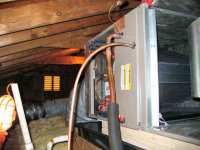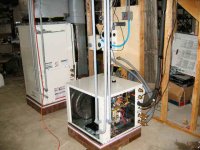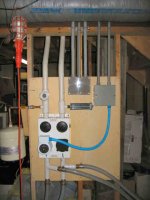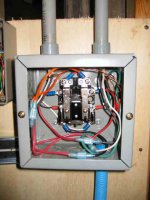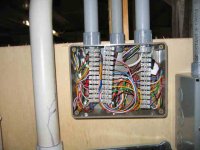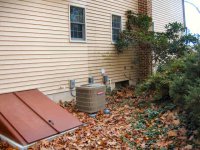You are using an out of date browser. It may not display this or other websites correctly.
You should upgrade or use an alternative browser.
You should upgrade or use an alternative browser.
Geothermal Heat Pump Project
- Thread starter techman
- Start date
- Views: 20892
/ Geothermal Heat Pump Project
#41
Chapter 12
With the attic finished, the 2nd floor compressor was installed. Mounted the same as the other unit, electrical, freon and water connections were made. The freon lines were triple evacuated and charged with the required amount of freon. The second unit was flushed in the same manner as before, and the loop valved to both units. The unit was started and performed as expected. The only real difference was that the long (60') freon line runs make it slower to get full heat output on the second floor unit as compared to the first floor system.
As stated earlier, I installed a 240 volt power relay for the circulator pump. Each geo unit has a power out to the circulator, which energizes when the unit runs. Since there is only one circulator for two units, the relay is used to operate the circulator when either unit runs. ClimateMaster makes a module to handle this task, but the relay was 1/3 of the price and simple to implement.
I also deviated from the trade norm which is to have the thermostat and compressor wiring all connect together at the airhandler. Since the airhandler was in the attic, in a not so easy to get to spot, I decided to bring all low voltage wiring to a central J-Box in the basement. This was If I added or changed anything in the low voltage wiring, I could do it in comfort, standing up.
More on Chapter 13
paul
With the attic finished, the 2nd floor compressor was installed. Mounted the same as the other unit, electrical, freon and water connections were made. The freon lines were triple evacuated and charged with the required amount of freon. The second unit was flushed in the same manner as before, and the loop valved to both units. The unit was started and performed as expected. The only real difference was that the long (60') freon line runs make it slower to get full heat output on the second floor unit as compared to the first floor system.
As stated earlier, I installed a 240 volt power relay for the circulator pump. Each geo unit has a power out to the circulator, which energizes when the unit runs. Since there is only one circulator for two units, the relay is used to operate the circulator when either unit runs. ClimateMaster makes a module to handle this task, but the relay was 1/3 of the price and simple to implement.
I also deviated from the trade norm which is to have the thermostat and compressor wiring all connect together at the airhandler. Since the airhandler was in the attic, in a not so easy to get to spot, I decided to bring all low voltage wiring to a central J-Box in the basement. This was If I added or changed anything in the low voltage wiring, I could do it in comfort, standing up.
More on Chapter 13
paul
Attachments
Chapter 13
The final phase of the project was the connection of the desuperheaters. As described earlier, each unit has a small heat exchanger that removes compression heat during heating and cooling operation. This option includes the heat exchanger, a small circulator and a thermostat limit switch. The desuperheater can put 1000-1500 BTUH per unit into the domestic hot water. While it can be connected directly to the existing hot water heater, the capacity of this recovered heat can be lowered. This is because the water in the HWH can be 120 or 130 degrees, which is near the desuperheat temperature, so with little temp difference, heat transfer can be reduced.
The better (but costlier) method is to install a second HWH that is used to store the recovered heat and act as a preheat tank for the main HWH. I chose this method. I installed a non-powered 50 gallon tank. The inlet is from the water supply, and the outlet feeds the normal powered HWH. The desuperheater system circulates water from the added tank, warms it and pumps it back into that tank. With the two geo units, check valves are added to each desuperheater water loop to isolate the flows and prevent cross circulation.
Beside the required piping, I added shut off valves and connections to each tank. This allows me to run the normal HWH as before or have it fed by the preheat tank. I can also use the preheat tank as the only HWH. In this mode I could hook up the power to the tank in the event of a failure on the normal tank.
In operation, depending on the run time of the geo units and out hot water usage, the preheat tank runs between 80-95 degrees. This warm water feeds the main HWH, instead of 50 deg well water. This is direct KWH savings for hot water. A very good feature that should always be included, in my opinion.
More in Conclusion
paul
The final phase of the project was the connection of the desuperheaters. As described earlier, each unit has a small heat exchanger that removes compression heat during heating and cooling operation. This option includes the heat exchanger, a small circulator and a thermostat limit switch. The desuperheater can put 1000-1500 BTUH per unit into the domestic hot water. While it can be connected directly to the existing hot water heater, the capacity of this recovered heat can be lowered. This is because the water in the HWH can be 120 or 130 degrees, which is near the desuperheat temperature, so with little temp difference, heat transfer can be reduced.
The better (but costlier) method is to install a second HWH that is used to store the recovered heat and act as a preheat tank for the main HWH. I chose this method. I installed a non-powered 50 gallon tank. The inlet is from the water supply, and the outlet feeds the normal powered HWH. The desuperheater system circulates water from the added tank, warms it and pumps it back into that tank. With the two geo units, check valves are added to each desuperheater water loop to isolate the flows and prevent cross circulation.
Beside the required piping, I added shut off valves and connections to each tank. This allows me to run the normal HWH as before or have it fed by the preheat tank. I can also use the preheat tank as the only HWH. In this mode I could hook up the power to the tank in the event of a failure on the normal tank.
In operation, depending on the run time of the geo units and out hot water usage, the preheat tank runs between 80-95 degrees. This warm water feeds the main HWH, instead of 50 deg well water. This is direct KWH savings for hot water. A very good feature that should always be included, in my opinion.
More in Conclusion
paul
Attachments
Conclusion
One overall comment describes the project - a lot of work. I did it without the benefit of any helpers, except for about 8 hours during trench layering backfill. I took it a bit slower as a result. I could have had helpers at times, but the schedule was too unknown, and I never felt (at the time) too stressed to ask for help.
General comments are that the house's level of comfort is much greater as compared to the older air source units. Warmer discharge air, no defrost cycles and greater capacity make up the majority of the difference. Another noted difference is quieter operation. There is no outdoor noise from the compressor/fans which could be heard near certain windows.
While the old units would run 24/7 in the coldest outdoor temps, the geo units rarely run more that 20 minutes at a time. Despite some very cold periods (single digits), the backup heat has not been on at all (after I tested them). The utility bills have reduced for sure. It is hard to make a real comparison yet, due to weather variations, comparing to the last 3 years I seem to be running about 1000-1500 KWH/month lower in the coldest months. Cooling savings should be even better. A year or two of data will really tell the difference.
The loop temperature (incoming water) started out at 50 degrees when I first started up, now at the end of the season it is about 38 degrees. The discharge water is below freezing and ice forms from condensate on exposed fittings. As I mentioned all of the loop piping is insulated due to condensation in the basement. No other problems have occurred.
As for cost, I can not mention too much detail on cost, since I am involved in the trade and buy at wholesale costs. What I can say is that the geo units themselves are about 2 times the cost of a modern high SEER heatpump of comparable size. Since the job is very labor intensive in many aspects, there will be a much higher overall cost to install a geo system. While a lot of the grunt work could be done by a handy DIYer, it is the problem of finding an installer that is willing to work with you to split the job.
In considering the geo system, I evaluated the cost of replacing (or installing) a new high SEER air sourced unit and looked at the cost difference from that baseline. A geo system like I installed would run about $ 20K in my area. This compares to about $ 9-10K for upgrading to a 2 zone air sourced system. The difference is of course about $ 10K. On average this is a 10+ year payback. If a DIY split were done, you might get the difference down to $ 5-7K, a more reasonable payback. A single unit, single zone system of the same capacity can save $ 1-2K more. I will get a reasonable payback, but that is more due to my costs and labor.
I think that the factors of increased comfort and reliability (most estimates are that geo units should have a 20+ year life due to fewer moving parts and not be located in the outdoor environment) should be factored in. Additionally the cost of energy will not go lower in the future, so energy savings may increase in the future. I think as geo becomes more popular, increase in installers and greater production quantities may lower prices somewhat as well.
I am a firm believer in geo heating and would highly recommend it to anyone who can afford it. I have a couple of new jobs already lined up this summer, and expect the interest to continue.
Thanks for reading and let me know if there are any more questions or facts.
paul
One overall comment describes the project - a lot of work. I did it without the benefit of any helpers, except for about 8 hours during trench layering backfill. I took it a bit slower as a result. I could have had helpers at times, but the schedule was too unknown, and I never felt (at the time) too stressed to ask for help.
General comments are that the house's level of comfort is much greater as compared to the older air source units. Warmer discharge air, no defrost cycles and greater capacity make up the majority of the difference. Another noted difference is quieter operation. There is no outdoor noise from the compressor/fans which could be heard near certain windows.
While the old units would run 24/7 in the coldest outdoor temps, the geo units rarely run more that 20 minutes at a time. Despite some very cold periods (single digits), the backup heat has not been on at all (after I tested them). The utility bills have reduced for sure. It is hard to make a real comparison yet, due to weather variations, comparing to the last 3 years I seem to be running about 1000-1500 KWH/month lower in the coldest months. Cooling savings should be even better. A year or two of data will really tell the difference.
The loop temperature (incoming water) started out at 50 degrees when I first started up, now at the end of the season it is about 38 degrees. The discharge water is below freezing and ice forms from condensate on exposed fittings. As I mentioned all of the loop piping is insulated due to condensation in the basement. No other problems have occurred.
As for cost, I can not mention too much detail on cost, since I am involved in the trade and buy at wholesale costs. What I can say is that the geo units themselves are about 2 times the cost of a modern high SEER heatpump of comparable size. Since the job is very labor intensive in many aspects, there will be a much higher overall cost to install a geo system. While a lot of the grunt work could be done by a handy DIYer, it is the problem of finding an installer that is willing to work with you to split the job.
In considering the geo system, I evaluated the cost of replacing (or installing) a new high SEER air sourced unit and looked at the cost difference from that baseline. A geo system like I installed would run about $ 20K in my area. This compares to about $ 9-10K for upgrading to a 2 zone air sourced system. The difference is of course about $ 10K. On average this is a 10+ year payback. If a DIY split were done, you might get the difference down to $ 5-7K, a more reasonable payback. A single unit, single zone system of the same capacity can save $ 1-2K more. I will get a reasonable payback, but that is more due to my costs and labor.
I think that the factors of increased comfort and reliability (most estimates are that geo units should have a 20+ year life due to fewer moving parts and not be located in the outdoor environment) should be factored in. Additionally the cost of energy will not go lower in the future, so energy savings may increase in the future. I think as geo becomes more popular, increase in installers and greater production quantities may lower prices somewhat as well.
I am a firm believer in geo heating and would highly recommend it to anyone who can afford it. I have a couple of new jobs already lined up this summer, and expect the interest to continue.
Thanks for reading and let me know if there are any more questions or facts.
paul
